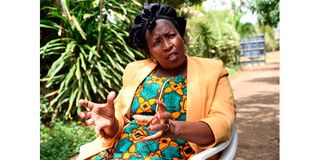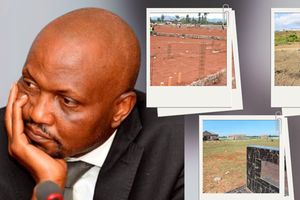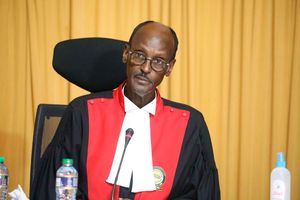How media is boosting visibility of women politicians

Dr Juliet Kimemiah, a candidate for the Kiambu County gubernatorial seat during an interview at her home on December 16, last year.
What you need to know:
- Media, women rights organisations equip women politicians with knowledge and skills to position themselves for coverage by the traditional media.
- Global Media Monitoring Project report says in 1995, the overall global presence of women in print, radio and TV in politics and government news was seven per cent, rising to 20 per cent in 2020.
- In Kenya, going by the topics covered in the media in 2020, they received zero to little coverage.
“Thanks to the media training, I have started creating content on TikTok to boost my popularity among the youth," said Dr Juliet Kimemiah, a candidate for Kiambu County's gubernatorial seat in Kenya's August 9 General Election.
She was speaking on December 9, 2021, during an Annual Human Rights Conference by Journalists for Human Rights (JHR) at a Nairobi hotel, where she shared her experience on how media literacy training has enabled her to increase her visibility in both mainstream and social media.
With her aggressiveness in promoting her visibility through social media, she has attracted many interviews on both print and broadcast media.
"I have become more aware of how to engage with the media. I find time to attend the interviews whenever they (journalists) call me," she said.
Dr Kimemiah noted that from the training, she has learned to take advantage of every opportunity availed to her for coverage, a skill she previously lacked.
Her experience tells of a twofold mechanism that, according to veteran media professionals, explains why there has been an increase in coverage of women in politics and government in the past 25 years.
Media and women rights organisations invest in equipping women politicians with knowledge and skills to position themselves for coverage by the traditional media.
Global presence
Second, having active and aggressive women politicians ready to take up the media challenge, the case of Dr Kimemiah and TikTok.
According to the 2020 Global Media Monitoring Project report by World Association for Christian Communication, in 1995, the overall global presence of women in print, radio and television in politics and government news was seven per cent, rising to 20 per cent in 2020.
In Kenya, going by the topics covered in the media in 2020, they received zero to little coverage.
In gender, celebrity, arts, media and sports, they received no coverage at all.
In crime and violence, their media visibility was at four per cent and 16 per cent for politics and government.
In the same year, women received a little more coverage in the economy (21 per cent), social and legal (25 per cent) and science and health (27 per cent).
The coverage, however, varies from one continent to another, with the Middle East (12 per cent), Asia (15 per cent) and Africa (18 per cent) trailing in the representation of women in politics and government as of 2020. Pacific continent leads with 32 per cent, after North America (26 per cent), Europe (22 per cent), the Caribbean (21 per cent) and Latin America (20 per cent).
Macharia Gaitho, former Managing Editor, Special Projects for the Daily Nation, attributes the change in the representation of women in political news to an increase in women in political leadership and deliberate measures by newsrooms to ensure balanced reporting.
"There are more women getting into politics and they are bound to get more coverage," he said.
For instance, in Kenya, in 2013, the first general election after the new Constitution, 47 Woman Representatives were elected. Additionally, in 2017, 23 women Members of Parliament were elected, an increase from 16 in the previous election year.
"There have also been deliberate efforts within media houses to set up gender desks," he added.
So far, at least two leading media houses, including Nation Media Group, have set up a gender desk to amplify women's voices in the news.
Training journalists on sensitive coverage of women has also contributed to better packaging of their stories, observed Mercy Njoroge, Gender Media Trainer at JHR.
"There have been many training of women politicians on how to sell their agenda. They are trained on how to package themselves to be newsworthy," said Ms Njoroge.
She said the training is part of the collaborative efforts between the media and women's rights organisations to boost women's visibility in the media.
"If more women get into politics yet they lack skills to engage with the media, their visibility will be low," she noted.
She added: "When they package themselves well, then people get to know who they are, what they stand for and their professions," she said.
She said training more women politicians on media literacy and journalists on gender-sensitive reporting was necessary.
"We need to train more women on how to work with the media to get positive coverage that will contribute to society seeing them as leaders and not as just women getting into politics," she said.
This story was supported by Code for Africa’s WanaData initiative and the World Association for Christian Communication.





